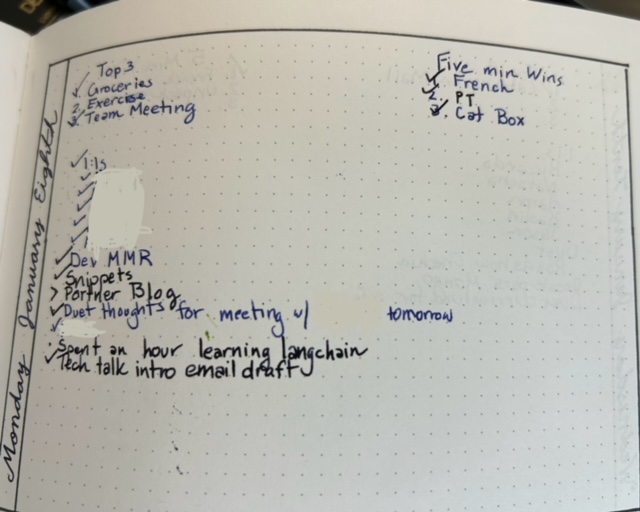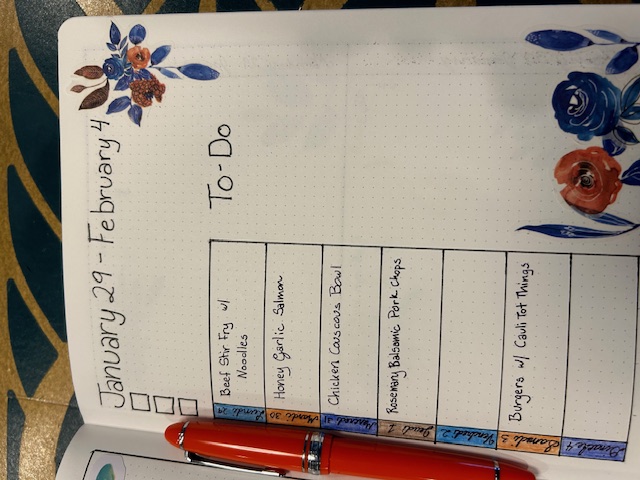Productivity Tools: Bullet Journal
My default nature is disorganized and chaotic. I was the kid whose school desk and room were always a mess. I nearly failed a class in middle school because I kept forgetting to turn in my homework. I’d do my homework and then leave it in my backpack. Over the years, I’ve tried many different systems to combat my natural entropy. In high school, I used the paper planner that my school gave to all students. I got through university using a variant of time blocking. Once I hit the working world, I tried all sorts of digital task trackers and spent several years as a heavy user of Omnifocus. However, nothing stuck until I switched to pencil and paper and adopted the Bullet Journal technique in 2017.
The thing I like about bullet journaling is that it is flexible. I’ve tried several paper planners as an adult. They either provide very little structure or so much structure that they don’t work for my life where there’s no average day. With bullet journaling, I can change things when they stop working, try new things, or skip entire weeks or days, and it’s okay. The Bullet Journal system has a few key components, like rapid logging (writing things down) and migration (retrospectives for your planning). But it can be customized to fit your unique needs. If part of the system doesn’t work for you, just don’t do it. Over the past seven years I’ve customized and streamlined the bullet journal system into something that works well for me. Maybe my system will inspire you.
The Notebook & Supplies
I prefer a classic hard-cover A5 dot grid notebook for my bullet journal. I like the size because it doesn’t occupy much desk space. I know I won’t use a notebook unless it is open on the desk in front of me, and A5 is small enough I can always have it open. A5 is also easy to carry, and hard-cover A5 notebooks aren’t damaged when I bring them back and forth to work in my bag. I don’t know why I prefer dot grid; I just do. I’ve tried lined and blank, and neither feels right.
Bullet journaling has a reputation for being complex and requiring artistic skills, and that’s not true. Personally, I do occasionally use stickers or colored pencils in my journal, but it isn’t required and I have plenty of pages with no decoration. For me the stickers, fancy lettering, and other ornaments are purely about keeping things interesting and having an artistic outlet.
The Daily “Page”
The core of my organization method is half a page per day. Why half a page? If I have more space, I fill it up and overcommit myself, and then I feel like a failure at 8 PM when I haven’t gotten everything done. Trial and error has taught me that on most days, I can do 2-3 big things and 5-7 little ones. So I give myself 15 - 20 lines per day, 10ish for tasks and another 10 for notes and doodles.
At the start of each day, I write down the three things that have to happen that day to make it a success. These are not the three most important things; they are just three things that have to get done for me to feel like I did my best that day. Some days, the top 3 things are blog posts, code, and amazing technical work. And some days, the top three things are groceries, taking out the trash, and going outside for more than 3 minutes. Usually, it is a mix of 1-2 mundane life things, and the rest are tasks for work. Next to my daily top 3, I write three “5-minute wins”. These are things I can finish in five minutes that I can pick up between meetings or when my motivation is low and I want an easy win. Short chores, making appointments, and my regular DuoLingo practice often end up on this list.
Underneath those things I copy my meetings and appointments for the day from my calendar. In any remaining space I add the tasks I want to get done. Copying my appointments over first makes it clear how much free time I’ll have for other tasks. If my meetings fill most of the half page for that day I shouldn’t plan on doing an additional 15 things. This is just another personal hack to force myself to be honest about my capabilities. Throughout the day I’ll add notes, ideas, and new tasks on any remaining lines in each days half-page.
Here is typical page from earlier this year with sensitive info obscured.

The Weekly Page & Migration
The other component of my spin on the bullet journal system is a weekly overview page. My current weekly overview has three components. At the top is my weekly top 3, which, like the daily top 3, is the list of three things that need to happen for the week to be a success.
Below that, I have a mini one-week calendar. I’m currently using this for meal planning, but I’ve used it for many different things. I’ve tracked workouts there, after-work commitments, or days in the office. It is an easy way to get a quick overview of the week.
Finally, I have a weekly To-do/Brain dump list. My To-do list is where everything I think I have to do this week or could potentially do gets written down. Everything goes on one list, whether it is for work or personal. This is the one list where I don’t worry about overcommitting. The goal of this list is to get all the things I need to do out of my head and on paper so I can chill out. Here’s an example before I filled in the To-Do section:

My weekly page is also where I do the migration part of the bullet journal method. At the start of a week (ideally), I go through the previous week’s pages and anything that did not get finished either gets marked as obsolete or gets added to this week’s to-do list. The migration process means that if I keep procrastinating on something, I have to write it again the next week and the week after that until I finally do it. This blog post, for example, has been migrated forward at least six times. Eventually, I get sick of writing the same thing every week, and I do the task, delegate it, or mark it obsolete. Occasionally, I’ll have a task or idea that I know I won’t get to at any time soon, but I’m not ready to give up altogether. Those tasks get copied to my “Someday List” elsewhere in my notebook. Every time I move to a new notebook, I migrate the “Someday List,” removing things that are no longer engaging.
The Reality
When I lay it out like this, it sounds like a lot, and I sound like some sort of organizational master. I want to be clear: I am not. My notebook has plenty of half-filled-out or blank pages. I still overplan my days at least once a week (today was particularly bad). I still occasionally miss deadlines. Perfection isn’t my goal. My goal is to find a system that I actually use more often than not that reduces my stress. And my particular spin on bullet journaling has filled that role for me.